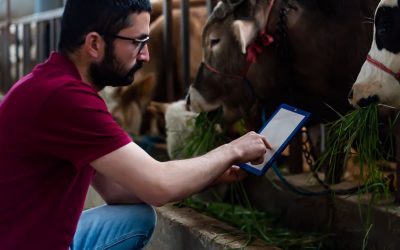Does Smart Farming Improve or Damage Animal Welfare? Technology and What Animals Want
What is smart farming?
Smart farming is a type of agriculture that uses technology to improve the efficiency of farm operations. This can include using sensors and data analysis to optimize irrigation, planting, and harvesting; using drones or robots for crop monitoring or livestock management; and using precision agriculture to reduce inputs such as water, fertilizer, and pesticides. Advocates of smart farming say that it can help farmers produce more food with fewer resources, while opponents argue that it can lead to more tremendous animal suffering. However, there is little scientific evidence to support either claim. Some animal welfare experts say that smart farming could potentially improve animal welfare by reducing the need for intensive management practices such as close confinement, routine mutilations, and the overuse of antibiotics.
Theoretical basis: what do animals want?
Animal welfare is a growing concern for many people, especially as we learn more about the ways animals are treated in factory farms. There is a lot of debate about what exactly constitutes “natural” for animals. Still, most welfare advocates agree that animals should at least have the opportunity to express their natural behaviours. For example, chickens in factory farms are typically confined to small cages where they can barely move, and this prevents them from engaging in important behaviours like dust bathing and stretching their wings. So, when we think about what animals want, we should keep in mind their basic needs for freedom from pain and suffering, and the opportunity to engage in natural behaviours.
Animal welfare in factory farms
Technology is playing an increasingly important role in both improving and damaging the welfare of animals raised in factory farms. On the one hand, technological advances have made it possible to raise animals in conditions that are far more humane than in the past. For example, pigs are now often raised in spacious pens with access to straw and other enrichment items rather than in tiny gestation crates. And chickens are typically given more space to move around and engage in natural behaviours like perching and dust-bathing. On the other hand, some of the most commonly used technologies in factory farms—such as fast-growing chicken breeds and artificial lighting—have been shown to cause significant welfare problems.
Benefits of smart farming for animal welfare
Though “smart farming” is a relatively new concept, it is one that is becoming more and more popular among those in the agricultural industry. But what exactly is smart farming? And how does it impact animal welfare? Smart farming can be defined as the use of technology to improve the efficiency of agricultural production. This includes everything from GPS-guided tractors to sensors that monitor soil moisture levels. The goal of smart farming is to produce more food with fewer resources, and with less impact on the environment. So, what does this mean for animals? When done correctly, smart farming has the potential to improve animal welfare significantly. For example, sensors can be used to monitor livestock health, identify sick animals early, and automatically dispense medication.
Drawbacks of smart farming for animal welfare
Smart farming is a type of agriculture that relies on technological advances to increase efficiency and optimize production. While smart farming has many potential benefits, there are also some drawbacks that could impact animal welfare. One potential drawback is that innovative farming technologies can be used to maximize production at the expense of animal welfare. For example, if animals are kept in cramped conditions or given growth hormones to promote faster growth, they may suffer from health problems and poor welfare. In addition, the use of robots or other automation in livestock management could lead to reduced interaction with animals, which could negatively impact their welfare. Another concern is that smart farming systems may be less resilient to disruptions than traditional systems. For example, if a power outage or equipment failure occurs, the animals may not receive the care they need in a timely manner. This could put their health and welfare at risk.
Conclusion
In conclusion, it is evident that there are pros and cons to smart farming. However, the technology is still relatively new, and there is much room for improvement. The key to making smart farming work for both farmers and animals is finding the right balance of technology and animal husbandry. Too much or too little of either can be detrimental to animal welfare and the government needs to put an extra focus on supporting tech-based animal health startups.



